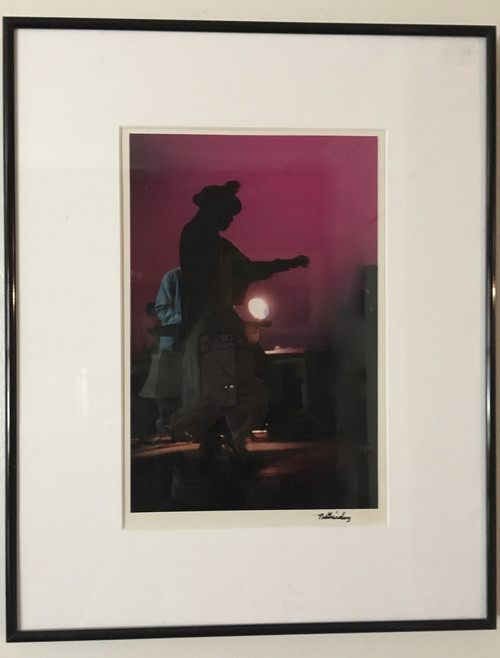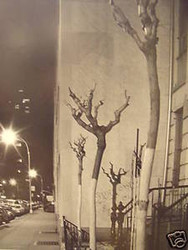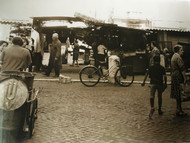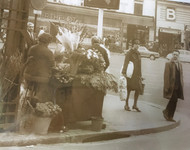Categories
Categories
- Home
- Photography
- NATHANIEL "NATE" GUIDRY: "Jazz Tap" Signed Photo Blk Framed Detroit News Ca 1994
NATHANIEL "NATE" GUIDRY: "Jazz Tap" Signed Photo Blk Framed Detroit News Ca 1994
Product Description
|
Description: NATHANIEL "NATE" GUIDRY: "Jazz Tap" Signed Photo Blk Framed Detroit News Ca 1994
Dimensions: 8 x 12 image; 20 x 16 Black custom frame, acid free mat
Condition: Very good, minor nicks frame. Minor tiny bend in photo
Shipping: $15.00
NATHANIEL "NATE" GUIDRY
Photojournalist for the Detroit News and Pittsburgh Post Gazette.
Ken Burns takes on the history of 'Jazz' Sunday, January 07, 2001 By Nate Guidry, Post-Gazette Staff Writer
Ken Burns is no stranger to documentary films. He has produced and directed everything from "Baseball" and "Huey Long" to "The Civil War," the highest-rated series in the history of American public television. It attracted an audience of nearly 40 million viewers during its premiere in 1990. Now the Brooklyn native turns his documentary acumen toward jazz in a 10-part, nearly 19-hour series that explores jazz from its origins in blues and ragtime to swing and bebop. A companion five-CD box set of music drawn from the shows, as well as a single recording titled "Overview," features music that spans the history of jazz. Of interest to Pittsburgh, though, is the picture of drummer Joe Harris performing with Dizzy Gillespie's big band, as well as the segment that addresses the musical relationship between Duke Ellington and Billy Strayhorn, whose careers spanned nearly 30 years. Ellington met a young Strayhorn during a Pittsburgh performance and gave him directions to his Harlem apartment from the Manhattan subway station. From those directions, Strayhorn composed "Take the A Train." The A Train runs through Harlem. "He was not, as he was often referred to by many, my alter ego," Ellington said. "He was my right arm, my left arm, all the eyes in the back of my head, my brainwaves in his head and his in mine." The series, which airs on PBS tomorrow through Jan. 22, traces the growth and development of jazz from New Orleans' Storyville red-light district to Chicago's Southside, where Louis Armstrong first received fame; from the early days of Count Basie and Benny Moten and the formation of the Kansas City blues-riff style to the courageous Billie Holiday, whose rasping sound turned marginal pop songs into timeless works of art. But of great interest to many will be the segment that traced the birth of bebop through its most ardent soldiers, including Pittsburgh drummer Kenny "Klook" Clarke, Thelonious Monk, Dizzy Gillespie and Charlie Parker, who helped to revolutionize jazz, then died a pauper's death from a combination of drug-related problems. He was 34. There's footage from big bands led by Benny Goodman, Charlie Barnet, Glenn Miller, Artie Shaw and others; some clips show how, through their music, they helped to increase the morale of U.S. troops during World War II. Performances in the South Pacific galvanized the troops, helping to remind them of what was uniquely American. But the series is far more than a collection of old footage and interviews. It's as Burns said, an "investigation of American history through the prism of jazz. Embedded in the music, in its riveting biographies and soaring artistic achievement, can be found our oft-neglected conscience, a message of hope and transcendence." True to that spirit, the documentary delivers. Written and produced with Geoffrey C. Ward and Lynn Novick, the documentary examines the culture, politics and dreams that gave birth to the music as well as many of the musicians responsible for its brilliance, including Miles Davis, whose constant quest to redefine himself through his music made him one of the most influential musicians of his generation. It's a wonderful synthesis of music, photographs and more than 2,000 archival film clips. Actor Keith David provides most of the narration. Other voices are provided by Samuel L. Jackson, Delroy Lindo, Derek Jacobi and Harry Connick Jr., among others. Interspersed throughout is commentary by the trumpeter Wynton Marsalis, as well as interviews with some of our foremost critics of the music, including Gary Giddins, Stanley Crouch and Albert Murray. The dynamics of race also get to swing a few crystalline notes. Some of music's most creative - and most tragic - personalities emerge, including pianist and pimp Ferdinand Joseph La Menthe, aka Jelly Roll Morton, a New Orleans Creole who claimed (truthfully or falsely) to have started jazz; to trumpeter/cornetist Nick LaRocca, who was the first to secure a jazz recording contract and insisted until the day he died that jazz was an exclusively white creation. The elegance of the Roseland Ballroom in Times Square, where only whites were allowed to attend, is juxtaposed against Harlem's Savoy Ballroom, a more egalitarian night-spot where everyone could mingle. In a year that celebrates the life and legacy of Armstrong (he was born 100 years ago this August), his shadow looms large throughout the series. It will be interesting to note that although the trumpeter grew up in New Orleans, he refused to be buried there. The racism he had experienced in the crescent city, even as an adult, proved more than he could deal with. In 1949, he had been invited back home to be King of the Zulu's parade. The parade is part of the annual Mardi Gras celebration. Originally, the Zulu Social Aid and Pleasure Club was founded to assure dues-paying members a decent burial. After the parade, he was scheduled to perform with his band but was denied the opportunity because his band had white members. "If I never see this place again it's all right with me," said bassist Arvelle Shaw recounting the words of Armstrong after his band was denied its performance. Conspicuously absent from the film, however, is much of music's history in its most recent manifestations. But those are minor details, that don't affect this musical trip through time set against the backdrop of American culture. |
 Loading... Please wait...
Loading... Please wait... 










